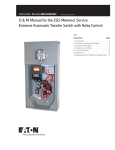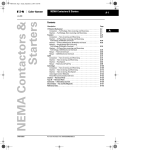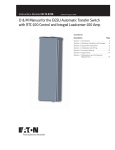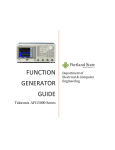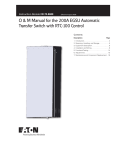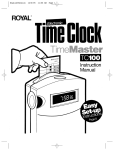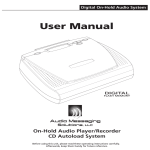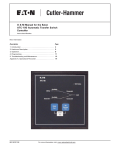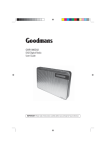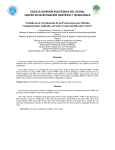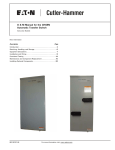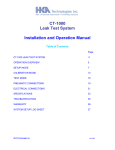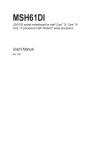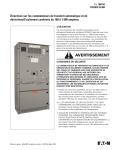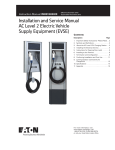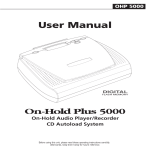Download O & M Manual for the EGS Service Entrance Automatic
Transcript
Instruction Booklet IB0162064EN Effective January 2014 O & M Manual for the EGS Service Entrance Automatic Transfer Switch Contents DescriptionPage 1.Introduction. . . . . . . . . . . . . . . . . . . . . . . . . . . . 2 2.Receiving, Handling, and Storage. . . . . . . . . . . 5 3.Equipment Description. . . . . . . . . . . . . . . . . . . 5 4.Installation and Wiring. . . . . . . . . . . . . . . . . . . . 8 5.Functional Testing. . . . . . . . . . . . . . . . . . . . . . 12 6.Adjustments . . . . . . . . . . . . . . . . . . . . . . . . . . 13 7.Maintenance and Component Replacement . 14 Instruction Booklet IB0162064EN O & M Manual for the EGS Service Entrance Automatic Transfer Switch Effective January 2014 Warning READ AND UNDERSTAND THE INSTRUCTIONS CONTAINED HEREINAFTER BEFORE ATTEMPTING TO UNPACK, ASSEMBLE, OPERATE, OR MAINTAIN THIS EQUIPMENT HAZARDOUS VOLTAGES ARE PRESENT INSIDE TRANSFER SWITCH ENCLOSURES THAT CAN CAUSE DEATH OR SEVERE PERSONAL INJURY. FOLLOW PROPER INSTALLATION, OPERATION, AND MAINTENANCE PROCEDURES TO AVOID THESE VOLTAGES. THE TRANSFER SWITCH EQUIPMENT COVERED BY THIS INSTRUCTION BOOK IS DESIGNED AND TESTED TO OPERATE WITHIN ITS NAMEPLATE RATINGS. OPERATION OUTSIDE OF THESE RATINGS MAY CAUSE THE EQUIPMENT TO FAIL RESULTING IN DEATH, SERIOUS BODILY INJURY, AND/OR PROPERTY DAMAGE. ALL RESPONSIBLE PERSONNEL SHOULD LOCATE THE DOOR MOUNTED EQUIPMENT RATINGS LABEL AND BE FAMILIAR WITH THE INFORMATION PROVIDED ON THE LABEL. A TYPICAL EQUIPMENT RATINGS LABEL IS SHOWN IN FIGURE 1. Figure 1. Typical Service Entrance Rated Metered Automatic Transfer Switch Ratings Label. All possible contingencies that may arise during installation, operation, or maintenance, and all details and variations of this equipment do not purport to be covered by these instructions. If further information is required by the purchaser regarding a particular installation, application, or maintenance activity, please contact an authorized Eaton sales representative or the installing contractor. Section 1: Introduction 1.1 Preliminary Comments and Safety Precautions This technical document is intended to cover most aspects associated with the installation, application, operation, and maintenance of the Automatic Transfer Switch (ATS). It is provided as a guide for authorized and qualified personnel only. Please refer to the specific WARNING and CAUTION in Section 1.1.2 before proceeding. If further information is required by the purchaser regarding a particular installation, application, or maintenance activity, please contact an authorized Eaton sales representative or the installing contractor. 1.1.1 Warranty and Liability Information No warranties, expressed or implied, including warranties of fitness for a particular purpose of merchantability, or warranties arising from course of dealing or usage of trade, are made regarding the information, recommendations, and descriptions contained herein. In no event will Eaton be responsible to the purchaser or user in contract, in tort (including negligence), strict liability, or otherwise for any special, indirect, incidental or consequential damage, or loss whatsoever, including but not limited to damage or loss of use of equipment, plant or power system, cost of capital, loss of power, additional expenses in the use of existing power facilities, or claims against the purchaser or user by its customers resulting from the use of the information and descriptions contained herein. 1.1.2 Safety Precautions All safety codes, standards, and/or regulations must be strictly observed in the installation, application, operation, and maintenance of this device. warning THE WARNINGS AND CAUTIONS INCLUDED AS PART OF THE PROCEDURAL STEPS IN THIS DOCUMENT ARE FOR PERSONAL SAFETY AND PROTECTION OF EQUIPMENT FROM DAMAGE. AN EXAMPLE OF A TYPICAL WARNING LABEL HEADING IS SHOWN ABOVE TO FAMILIARIZE PERSONNEL WITH THE STYLE OF PRESENTATION. THIS WILL HELP TO ENSURE THAT PERSONNEL ARE ALERT TO WARNINGS, WHICH APPEAR THROUGHOUT THE DOCUMENT. IN ADDITION, CAUTIONS ARE ALL UPPER CASE AND BOLDFACE. CAUTION READ AND UNDERSTAND THE MATERIAL PRESENTED IN THIS DOCUMENT BEFORE ATTEMPTING INSTALLATION, APPLICATION, OPERATION, OR MAINTENANCE OF THE EQUIPMENT. IN ADDITION, ONLY QUALIFIED PERSONS SHOULD BE PERMITTED TO PERFORM ANY WORK ASSOCIATED WITH THE EQUIPMENT. ANY WIRING INSTRUCTIONS PRESENTED IN THIS DOCUMENT MUST BE FOLLOWED PRECISELY. FAILURE TO DO SO COULD CAUSE PERMANENT EQUIPMENT DAMAGE. 2 Eaton Corporation www.eatoncanada.ca Instruction Booklet IB0162064EN O & M Manual for the EGS Service Entrance Automatic Transfer Switch Effective January 2014 1.2 General Information 1.2.1 Design Configuration ATSs are used to protect critical electrical loads against loss of power. The load’s utility power source is backed up by a generator power source. An ATS is connected to both the utility and generator power sources and supplies the load with power from one of these two sources. In the event that power is lost from the utility power source, the ATS transfers the load to the generator power source. Once the utility power is restored, the load is automatically transferred back to the utility power source (Figure 2). The Eaton Service Entrance Rated, Automatic Transfer Switch is a rugged, compact design that combines a service entrance rated disconnect, and ATS all in a single enclosure. The design provides for top entry service cabling from the meter socket. A factory wired 100 or 200A circuit breaker provides a Canadian approved service entrance rated disconnect means. The ATS is controlled by an Eaton RTC-100 controller or relay, and utilizes power contactors to transfer essential loads from one power source to another (see Figure 3). The switch’s design uses suitable mechanical and electrical interlock switches to eliminate the possibility of connecting the utility service to the generator output. In addition, a manual override lever is provided for the transfer function. Generator Utility warning Do not manually transfer THE switch while under load. Figure 3. EGSCA200ASE (200 A). Load Figure 2. Typical Load Transfer Switch (Contactor) Schematic. An intelligence system initiates the transfer when the utility power source fails or falls below a preset voltage. An engine start is then initiated by the ATS or the generator and the ATS transfers to the generator power source when sufficient generator voltage is available. When the utility power source is restored, the ATS automatically transfers back and the generator will shut down after a time delay. In the event the utility power source fails and the generator power source does not appear, the ATS remains connected to the utility power source until the generator power source does appear. Conversely, if connected to the generator power source and the generator power source fails while the utility power source is still unavailable, the ATS remains connected to the generator power source. ATSs automatically perform the transfer function, and include three basic elements. 1. Main contacts to connect and disconnect the load to and from the source of power. 2. Solenoids to make the transfer of the main contacts from source to source. 3. Intelligence/supervisory circuits to constantly monitor the condition of the power sources and thus provide the intelligence necessary for the switch and related circuit operation. Eaton Corporation www.eatoncanada.ca 3 Instruction Booklet IB0162064EN O & M Manual for the EGS Service Entrance Automatic Transfer Switch Effective January 2014 The benefits of the SE configuration are: • Combined service disconnect and over-current protection in the ATS reduces the overall equipment and installation costs. • Fewer components and power connections reduce maintenance requirements. 1.5 Glossary With respect to their use within this document and as they relate to transfer switch and controller operation, the following terminology is defined. 1.2.3 Load Shed Contacts Available Two sets of contacts are available with the transfer switches that utilize the RTC-100 controller, and can be used to control large connected loads on the generator (i.e. air conditioners, hot tubs, etc.). The contacts are rated for 250 Vac, 5 amps maximum. This functionality requires that Load monitoring CT’s are installed (sold separately) Connected 1.3 Transfer Switch Catalogue Number Identification ATS equipment catalogue numbers provide a significant amount of relevant information pertaining to a specific piece of equipment. The Catalogue Number Identification Table (see Table 1) provides the required interpretation information. Table 1. ATS Catalogue Numbering System. E GS Manufacturer Eaton Type Generator Switch C = Relay CA=RTC100 Failed or Fails A source is defined as “failed” when it is outside of the applicable voltage setpoint ranges for the nominal voltage and for a time exceeding 0.5 seconds after the time delay emergency fail (TDEF) time delays expires. Failsafe is a feature that prevents disconnection from the only available power source and also forces a transfer or re-transfer operation to the only available power source. Service Entrance Ampere Rating 100 or 200 Connected is defined as when the input is shorted by an external contact or connection. Failsafe CA 200A SE Transfer Control A source is defined as “available” when it is within its undervoltage setpoint ranges for the nominal voltage setting. Canadian Service Entrance Approved Re-Transfer Re-transfer is defined as a change of the load connection from the Generator to the Utility. Utility Utility is the primary source (normal source, normal power source, or normal). Generator 1.4 Environmental and Operational Conditions Normally, an ATS is applied indoors in an electrical equipment room. It can also be used for normal outdoor applications (with standard type 3R enclosure) where the equipment is subject to falling rain, freezing temperatures, and 95% humidity (non-condensing). The ambient temperature range for operation is between -20 and 70°C (-4 and 158°F).. Generator is the secondary source (generator emergency source, emergency power source, emergency, standby, or backup source). Utility: Failed or Fails Utility is defined as “failed” when it is outside of its undervoltage setpoint ranges for the nominal voltage and frequency setting. Generator: Failed or Fails Generator is defined as “failed” when it is outside of its undervoltage/underfrequency/overfrequency (if applicable) setpoint ranges for the nominal voltage and frequency setting for a time exceeding 0.5 seconds after the Time Delay Emergency Fail (TDEF) time delay expires. Transfer Transfer is defined as a change of the load connection from the Utility to the Generator power source. Unconnected Unconnected is defined as when the input is not shorted by an external contact or connection. 4 Eaton Corporation www.eatoncanada.ca O & M Manual for the EGS Service Entrance Automatic Transfer Switch Instruction Booklet IB0162064EN Effective January 2014 Section 2: Receiving, Handling, and Storage 2.1 Receiving Every effort is made to ensure that the ATS equipment arrives at its destination undamaged and ready for installation. The packing is designed to protect the internal components as well as the enclosure. Care should be exercised, however, to protect the equipment from impact at all times. Do not remove the protective packaging until the equipment is at the installation site and ready to be installed. When the ATS equipment reaches its destination, the customer should inspect the shipping container for any obvious signs of rough handling and/or external damage that occurred during transportation. Record any external and internal damage for reporting to the transportation carrier and to the Eaton sales representative, once a thorough inspection is complete. All claims should be as specific as possible and include the Shop Order and General Order numbers. A shipping label affixed to the shipping container includes a variety of equipment and customer information, such as General Order and catalogue numbers. Make certain that this information matches the other shipping paper information. Each ATS enclosure is packaged in its own box. Do not discard the packing material until the equipment is ready for installation. Once the packaging is removed from the shipment, the enclosure door can be opened. A plastic bag of documents will be found in the enclosure. Important documents, such as wiring diagrams and appropriate instruction leaflets are enclosed within the bag and should be filed in a safe place. 2.2 Handling As previously mentioned, ATS equipment is packaged in its own box. Protect the equipment from impact at all times and do not double stack. Once the equipment is at the installation site and ready to be installed, the packaging material can be removed. Refer to Section 4 of this manual for specific installation instructions. 2.3 Storage Although well packaged, this equipment is not suitable for outdoor storage. The equipment warranty will not be applicable if there is evidence of outdoor storage. If the equipment is to be stored indoors for any period of time, it should be stored with its protective packaging material in place. Protect the equipment at all times from excessive moisture, construction dirt, corrosive conditions, and other contaminants. It is strongly suggested that the package-protected equipment be stored in a climate-controlled environment of -20 to 70°C (-4 to 158°F), with a relative humidity of 80% or less. Do not, under any circumstance, stack other equipment on top of an ATS equipment enclosure, whether packaged or not. Eaton Corporation www.eatoncanada.ca 5 Instruction Booklet IB0162064EN Effective January 2014 O & M Manual for the EGS Service Entrance Automatic Transfer Switch Section 3: Equipment Description 3.1 Introduction The Eaton metered, service entrance rated ATS is assembled and tested at the factory. It is designed to be used in conjunction with standby power distribution equipment to provide an alternate source of power to critical circuits in the event that the primary power source is interrupted. The Advanced ATS with RTC100 control monitors both utility and generator power sources and automatically transfers critical load circuits between the two sources, depending on which source is available. The utility power source is preferred and will remain connected to the switch if it is available. The Relay ATS relies on the Generator Controller to monitor utility and generator power, and signals the relay to control ATS position. 3.2 Service Disconnect The Service Entrance (SE) section of the ATS is used for making the primary utility power, and neutral connections. Factory cabling from the load side of the main circuit breaker service disconnect connects to the utility lugs of the power contactor assembly. (Figure 6). 3.2.1 Main Contacts This ATS incorporates a power contactor. The main contacts connect and disconnect the load to and from the different power sources. The power contactor is mechanically and electrically interlocked to prevent the two sets of main contacts from being closed simultaneously. Figure 4. Typical Advanced 200 Ampere Interior Assembly. 3.3 RTC-100 Logic Panel on EGSCA100ASE and EGSCA200ASE The RTC-100 is a microprocessor-based transfer switch logic control package. The hardware and software of the controller contain the intelligence/supervisory circuits that constantly monitor the condition of the power sources. It provides the intelligence necessary for the operation of the ATS. Please refer to IB 70-8698 for complete details. The RTC-100 controller has an operating temperature of -20 to 70°C (-4 to 158°F). The controller circuit board is protected by an insulating conformal coating. The specifications, under normal operating conditions, are as follows: • Tolerance for voltage sensing function: ±1% of full scale • Tolerance for frequency sensing function: ±0.3 Hz of setting 6 Eaton Corporation www.eatoncanada.ca Instruction Booklet IB0162064EN O & M Manual for the EGS Service Entrance Automatic Transfer Switch Effective January 2014 Figure 5. Typical Basic 100 Ampere Interior Assembly. UC1: Utility Coil 1 UC2: Utility Coil 2 N1: Normal (utility ) 1 N2: Normal (utility) 2 USW: Utlity switch position GSW: Generator switch position GC1: Generator coil 1 GC2: Generator coil 2 E1: Emergency line 1 E2: Emergency line 2 L1: Load line 1 L2: Load line 2 F1: Fuse line 1 (used for utility sensing to generator) F2: Fuse line 2 (used for utility sensing to generator) REL: Transfer signal Relay 23, 194: Transfer signal connection from generator Install T1 Fuse Block (provided with generator) in this position, install jumper to L1 or L2 to ensure generator battery is charging when on utility and on generator source Eaton Corporation www.eatoncanada.ca 7 Instruction Booklet IB0162064EN O & M Manual for the EGS Service Entrance Automatic Transfer Switch Effective January 2014 4.5 Generator & Load Power Cable Connection warning POWER CONDUCTORS MAY HAVE VOLTAGE PRESENT THAT CAN CAUSE SEVERE PERSONAL INJURY OR DEATH. DE-ENERGIZE ALL POWER OR CONTROL CIRCUIT CONDUCTORS TO BE CONNECTED TO THE ATS EQUIPMENT BEFORE BEGINNING TO WORK WITH THE CONDUCTORS AND/ OR TERMINATING THEM TO THE EQUIPMENT CAUTION TO HELP PREVENT COMPONENT DAMAGE OR FUTURE MALFUNCTIONS, USE EXTREME CARE TO KEEP CONTAMINANTS OUT OF THE ATS EQUIPMENT WHEN MAKING THE POWER CABLE CONNECTIONS. Test all power cables prior to connection to the unit to ensure that the conductors or cable insulation has not been damaged while being pulled into position. Power cables are to be connected to solderless, screw type lugs located on the contactor assembly. Verify that the lugs supplied will accommodate the power cables being used. Also verify that the cables comply with all local electrical codes. Standard ATS equipment, as supplied from the factory, will accommodate the wire sizes shown in Table 3. Table 3. Wire Sizes for ATSs. Transfer Switch Amp Rating Contactor Lug Size Range Number of Cables per Phase 100 #14 - 1/0 AWG 1 200 #4 AWG - 300 MCM 1 Figure 8. Generator & Load Power Cable Connection Locations. 4.6 Wiring CAUTION IMPROPER POWER CABLE CONNECTIONS CAN CAUSE EXCESSIVE HEAT AND SUBSEQUENT EQUIPMENT FAILURE. NNote: Tighten the cable lugs to the torque identified on the label affixed to the unit’s door. WARNING POWER CONDUCTORS AND control wiring MAY HAVE VOLTAGE PRESENT THAT CAN CAUSE SEVERE PERSONAL INJURY OR DEATH. DE-ENERGIZE ALL POWER OR CONTROL CIRCUIT CONDUCTORS BEFORE BEGINNING TO PERFORM ANY WIRING ACTIVITY TO OR WITHIN THE ATS EQUIPMENT. Connect cables as follows (see Figure 10, and Table 3): • The generator power cables to the generator lugs on the contactor assembly. • The load power cables to the load lugs on the contactor assembly. • The generator neutral cable to the generator neutral lug on the neutral bar assembly. • The load neutral cable to the load neutral lug on the neutral bar asssembly. • The generator and load ground cable to the generator and load ground lugs on the ground bar assembly. Warning Failure to properly connect this transfer switch per NFPA 70, the national electric code, may result in product failure, fire, loss of property, loss of life, ETc. 8 Eaton Corporation www.eatoncanada.ca CAUTION CHECK THE ATS EQUIPMENT NAMEPLATE FOR RATED VOLTAGE. IT SHOULD BE THE SAME AS THE UTILITY AND GENERATOR LINE VOLTAGES. OPERATING THE EQUIPMENT ON IMPROPER VOLTAGE CAN CAUSE EQUIPMENT DAMAGE. Instruction Booklet IB0162064EN O & M Manual for the EGS Service Entrance Automatic Transfer Switch Effective January 2014 4.7 Installation 4.9 Protection In a typical installation (see Figure 11), the generator (2) and utility power connect to the ATS (1). Power from the utility or the gnerator (2) is fed to the main circuit breaker panel from the ATS (1). The circuit breaker in the ATS is the service entrance disconnect for the installation. For Catalogue #EGSC100ASE, EGSCA100ASE, EGSC200ASE and EGSCA200ASE When the utility power fails, the ATS will sense the failure, the generator will start, and when sufficient generator voltage is available, the ATS will switch. All loads will receive power from the generator. When utility power returns, the ATS will switch all power back to the utility source and the generator will shut down after its defined cooled down period. This switch is equipped with integral over-current protection. Continuous load current not to exceed 80 percent of switch rating. This Transfer Switch is rated for use on a circuit capable of delivering not more than 10,000 rms symmetrical amperes, 240 volts maximum. Section 5: Functional Testing WARNING 4.7 Generator Start Connection The generator start contact connection terminal blocks are located on the RTC100 controller. NNote: Prior to making the generator start connection to the ATS, set the generator control selector switch to the OFF position to prevent an unwanted generator start. Control wiring, such as the generator start wires, must be run in a separate conduit from the power cables. A normally open and normally closed contact as well as a common from the RTC-100 control board are wired out to this set of terminal blocks. The RTC-100 controller initiates the start of the generator by closing or opening these contacts. The start signal requirements of the generator will determine which contact is used to control the start up. Use the proper wire size as listed by the generator set (Genset) manufacturer 4.8 Preliminary Checks After the ATS enclosure is installed and power cables are connected to the equipment, thoroughly inspect the unit to ensure that no tools were left inside and that the cabinet is free of debris. If necessary, use a vacuum cleaner to remove any and all construction or installation debris from the equipment. Read and understand all labels on the equipment. Review and understand the wiring diagrams supplied with the equipment. Note any optional accessories that may have been furnished with this unit and review their operation. Verify that the phase-to-phase line voltages of both the utility and generator power sources are the same and that they match the rated voltage as indicated on the ATS ratings label. CAUTION SEVERE EQUIPMENT DAMAGE CAN RESULT IF THE UNIT IS NOT APPLIED AT PROPER VOLTAGE. DO NOT ENERGIZE THE EQUIPMENT IF THE SUPPLY VOLTAGES DO NOT MATCH EQUIPMENT RATINGS LABEL. YOU ARE READY TO ENERGIZE THE EQUIPMENT. VOLTAGES WITHIN THE ENCLOSURE ARE CAPABLE OF CAUSING SEVERE PERSONAL INJURY OR DEATH. USE EXTREME CAUTION TO AVOID CONTACT WITH ENERGIZED EQUIPMENT. 5.1 Preliminary Checks Step 1: Check all loads connected to the ATS to ensure that they are ready to be energized. 5.2 Energize the Switch Step 1: With the service entrance barrier removed use a voltmeter to measure the line-to-line and the line-to-neutral voltages on the line side of the circuit breaker. Confirm the utility voltage is correct then replace the service entrance barrier. Step 2: Ensure the generator control selector switch located on the standby generator is set to the OFF position. If so equiped, remove the control fuse from the generator control panel to ensure the generator does not iniate a start during this phase of the preliminary check. Open the generator power source circuit breaker located on the generator assembly. Step 3: Close the service entrance disconnect circuit breaker in the switch to connect the ATS to the utility power source voltage. If the ATS unit is not already in the UTILITY position, and the voltage is acceptable, the solenoid will engage and the contactor will automatically switch to the UTILITY position. WARNING CONTACT WITH ENERGIZED COMPONENTS WILL CAUSE ELECTRICAL SHOCK CAPABLE OF PRODUCING SEVERE PERSONAL INJURY OR DEATH. USE EXTREME CAUTION TO AVOID CONTACT WITH ENERGIZED COMPONENTS WHEN USING A METER FOR VOLTAGE CHECKS. Step 4: Replace the control fuse in the generator control panel removed in Step 2 of Section 5.2. Position the generator control selector switch, located on the standby generator, to the AUTOSTART position. (It may also be labeled REMOTE START or AUTO.). Close the generator power source circuit breaker opened in Step 2 of Section 5.2. Eaton Corporation www.eatoncanada.ca 9 Instruction Booklet IB0162064EN Effective January 2014 5.3 Operational Checks Step 1: Open the service entrance disconnect circuit breaker originally closed in Step 3 of Section 5.2. NOTICE This will simulate an interruption of the utility power source. Step 2: After a time delay (based on the generator settings), the standby generator engine will start. Step 3: Using a voltmeter, measure the line-to-line and line-to-neutral voltages across the generator line terminals to ensure that the generator emergency voltage is correct. If necessary, make adjustments to the voltage regulator on the generator according to the manufacturer’s recommendations to correct any voltage deviations. The ATS will only respond to the correct voltage from the generator power source. Step 4: The ATS Time Delay Normal (Utility) to Emergency (Generator) (TDNE) will begin to time after the generator engine begins to run. After time out, the solenoid will engage and the contactor will automatically switch from the UTILITY to the GENERATOR position. Step 5: Close the service entrance disconnect circuit breaker described in Step 3 of Section 5.2. Step 7: The ATS Time Delay Emergency (Generator) to Normal (Utility) (TDEN) timer will begin timing, and the solenoid will engage and automatically switch from the GENERATOR to the UTILITY position and the generator will shut down after a cool down period. 10 Eaton Corporation www.eatoncanada.ca O & M Manual for the EGS Service Entrance Automatic Transfer Switch Instruction Booklet IB0162064EN O & M Manual for the EGS Service Entrance Automatic Transfer Switch Effective January 2014 5.4 Manual Operation Section 6: Adjustments warning DO NOT ATTEMPT TO MANUALLY OPERATE THE ATS WITH the utility OR generator AVAILABLE. 6.1 General Refer to IB01602019E, supplied with the ATS for ATC-100 Controller adjustments and programming. warning HIGH VOLTAGES ARE PRESENT IN AND AROUND TRANSFER SWITCH EQUIPMENT. BEFORE ATTEMPTING TO MANUALLY TRANSFER, DISCONNECT THE LINE POWER FROM THE EQUIPMENT BEING SERVICED BY OPENING AND LOCKING OUT, IF POSSIBLE, THE NEXT HIGHEST DISCONNECT DEVICE. FAILURE TO FOLLOW THIS PROCEDURE COULD CAUSE SEVERE PERSONAL INJURY AND/OR DEATH. ALWAYS TURN THE utility POWER OFF AND TURN THE generator (IF A GENERATOR) CONTROL SELECTOR SWITCH TO THE “oFF” POSITION BEFORE ATTEMPTING A MANUAL TRANSFER. warning InsurE THE DEADFRONT IS INSTALLED PRIOR TO energizing the TRANSFER SWITCH. To Manually Operate Step 1: Disconnect all sources of power. Step 2: Disconnect the J7 connector from the ATC-100 controller. Step 3: Locate the manual lever between the solenoids.. Step 4: Locate the handle used to manually transfer the switch. Step 5: Attach the handle to the manual lever. Step 6: Move the lever up to go to utility or move the lever down to go to generator. Step 7: Reconnect the power. Step 8: If automatic operation is required, disconnect all sources of power, reinstall the J7 connector, and reconnect the power. Figure 9. ATS Manual Operating Lever. Figure 10. ATS Manual Operating Handle. Eaton Corporation www.eatoncanada.ca 11 Instruction Booklet IB0162064EN O & M Manual for the EGS Service Entrance Automatic Transfer Switch Effective January 2014 Section 7: Maintenance and Component Replacement 7.1 Introduction WARNING HIGH VOLTAGES ARE PRESENT IN AND AROUND TRANSFER SWITCH EQUIPMENT. BEFORE INSPECTING OR MAINTAINING THIS EQUIPMENT, DISCONNECT THE LINE POWER FROM THE EQUIPMENT BEING SERVICED BY OPENING AND LOCKING OUT, IF POSSIBLE, THE NEXT HIGHEST DISCONNECT DEVICE. FAILURE TO FOLLOW THIS PROCEDURE COULD CAUSE SEVERE PERSONAL INJURY AND/OR DEATH. In general, ATS equipment is designed to be relatively maintenance free under normal usage. However, because of the variability of application conditions and the importance placed on dependable operation by this type of equipment, inspection and maintenance checks should be made on a regularly scheduled basis. Since equipment maintenance will consist mainly of keeping the equipment clean, the frequency of maintenance will depend, to a large extent, on the cleanliness of its surroundings. If a significant amount of dust or foreign matter is present, a more frequent maintenance schedule should be followed. It is suggested that visual inspections of the equipment be made on a regular basis, not just during regularly scheduled periods. Always be alert for an accumulation of dirt in and around the structure, loose parts and/or hardware, cracks and/or discoloration to insulation, and damaged or discolored components. Figure 16 is the wiring diagram for the EGS ATS switch. NNote: Only qualified and experienced personnel should attempt any diagnostic work using this diagram. 7.2 Procedures A suggested maintenance procedure to be followed is outlined in Table 4. Table 4. Recommended Periodic Maintenance Procedures 12 Step Action a. Make the transfer switch equipment safe for inspection and/or maintenance. Disconnect the line power from the equipment being serviced by opening next highest disconnect device. Make certain that any accessory control power is switched off. b. Inspect the structure area for safety hazards or potential maintenance problems. Inspect the area, especially where the contactor is installed, for any safety hazards, including personal safety and fire hazards. Exposure to certain chemical vapors can cause deterioration of the electrical connections. Inspect for accumulated dirt, loose hardware, or physical damage. Examine the primary insulation for evidence of cracking or overheating. Overheating will show as discoloration, melting, or blistering of the conductor insulation, or as pitting or melting of the conductor surfaces due to arcing. Inspect the secondary control connections for damage, and control wiring for insulation integrity. c. Inspect the contactor for dust, dirt, soot, grease, moisture, or corrosion. Remove dust, dirt, soot, grease, moisture, and corrosion contamination from the surface of the switching device using a dry, soft lint-free cloth, dry soft bristle brush, and vacuum cleaner. Do not blow debris into the contactor. If contamination is found, look for the source and fix the problem. d. Check for material integrity, uneven wear, discoloration, or loose hardware. Severe material cracking will require replacement and loose hardware will need to be tightened. e. Check the terminals and connectors for looseness or signs of overheating. Overheating will show as discoloration, melting, or blistering of the conductor insulation. Connections that do not have signs of looseness or overheating should not be disturbed. f. Exercise the contactor if it is not often exercised while in operation. This will permit the wiping action by the contacts. If a switching device is used for frequent switching during normal operation, this step can be disregarded. g. Return the transfer switch equipment to service. Make certain all barriers are in place and the door is closed. Re-apply generator and utility power. Eaton Corporation www.eatoncanada.ca O & M Manual for the EGS Service Entrance Automatic Transfer Switch Instruction Booklet IB0162064EN Effective January 2014 Figure 11. Wiring Diagram for the EGS ATS (Shown Connected to Normal Source 1- (N) Utility). Eaton Corporation www.eatoncanada.ca 13 Instruction Booklet IB0162064EN Effective January 2014 7.3 Maintenance Log 14 Date Action Example: 01/01/12 Inspected and cleaned. Eaton Corporation www.eatoncanada.ca O & M Manual for the EGS Service Entrance Automatic Transfer Switch Instruction Booklet IB0162064EN O & M Manual for the EGS Service Entrance Automatic Transfer Switch Effective January 2014 7.4 Component Replacement Certain components within the ATS are field replaceable. Table 5 lists the part numbers to use when ordering replacement components. To order replacement components, contact an authorized Eaton Sales Representative. Table 5. Field Replaceable Components. Component Part Number ATS Model Contactor 99-5638 100A Contactor 99-5702 200A RTC-100 Controller RTC100 100/200A Service Entrance Breaker CSR2100 & MCBK225 100A Service Entrance Breaker CSR2200 & MCBK225 200A WARNING HIGH VOLTAGES ARE PRESENT IN AND AROUND TRANSFER SWITCH EQUIPMENT. BEFORE ATTEMPTING TO REPLACE ANY COMPONENT, DISCONNECT THE LINE POWER FROM THE EQUIPMENT BEING SERVICED BY OPENING AND LOCKING OUT, IF POSSIBLE, THE NEXT HIGHEST DISCONNECT DEVICE. FAILURE TO FOLLOW THIS PROCEDURE COULD CAUSE SEVERE PERSONAL INJURY AND/OR DEATH. ALWAYS TURN THE UTILITY (SOURCE 1) POWER OFF AND TURN THE GENERATOR (SOURCE 2) CONTROL SELECTOR SWITCH TO THE “OFF” POSITION BEFORE ATTEMPTING TO REPLACE ANY COMPONENTS. NOTICE Apply utility (source 1) power and place the generator control selector switch in the “AUTO” position after the component has been replaced. Test the system for proper functionality. 7.5 Troubleshooting Table 6 contains troubleshooting information for the EGS ATS. If a problem still exists after completing the troubleshooting procedures, contact an authorized Eaton sales representative. Table 6. Troubleshooting Chart. Problem Cause Correction The automatic transfer switch does not transfer to the generator. 1 The generator breaker is open. 2. The generator voltage is not acceptable. 1. Reset the generator circuit breaker. 2. Refer to the generator User’s Manual The automatic transfer switch does not transfer to the utility. 1. The service disconnect breaker is open. 2. The utility voltage is not acceptable. 1. Reset the service disconnect breaker. 2. Wait for the utility voltage to return to normal The generator is still running after the transfer switch transfers to the utility. Engine cool down period. The engine should stop after the cool down. Eaton Corporation www.eatoncanada.ca 15 Instruction Booklet IB0162064EN Effective January 2014 Figure 12. Dimensions and Plan View of a Service Entrance EGS (in.) (200A). 16 Eaton Corporation www.eatoncanada.ca O & M Manual for the EGS Service Entrance Automatic Transfer Switch O & M Manual for the EGS Service Entrance Automatic Transfer Switch Instruction Booklet IB0162064EN Effective January 2014 Notes: Eaton Corporation www.eatoncanada.ca 17 Instruction Booklet IB0162064EN Effective January 2014 This instruction booklet is published solely for information purposes and should not be considered all-inclusive. If further information is required, you should consult an authorized Eaton sales representative. The sale of the product shown in this literature is subject to the terms and conditions outlined in appropriate Eaton selling policies or other contractual agreement between the parties. This literature is not intended to and does not enlarge or add to any such contract. The sole source governing the rights and remedies of any purchaser of this equipment is the contract between the purchaser and Eaton. NO WARRANTIES, EXPRESSED OR IMPLIED, INCLUDING WARRANTIES OF FITNESS FOR A PARTICULAR PURPOSE OR MERCHANTABILITY, OR WARRANTIES ARISING FROM COURSE OF DEALING OR USAGE OF TRADE, ARE MADE REGARDING THE INFORMATION, RECOMMENDATIONS, AND DESCRIPTIONS CONTAINED HEREIN. In no event will Eaton be responsible to the purchaser or user in contract, in tort (including negligence), strict liability or otherwise for any special, indirect, incidental or consequential damage or loss whatsoever, including but not limited to damage or loss of use of equipment, plant or power system, cost of capital, loss of power, additional expenses in the use of existing power facilities, or claims against the purchaser or user by its customers resulting from the use of the information, recommendations and description contained herein. Eaton Corporation Electrical Group 5050 Mainway Burlington, ON L7L 5Z1 Canada 1-800-268-3578 www.eatoncanada.ca © 2012 Eaton Corporation All Rights Reserved Printed in Canada Publication No. IB.31F.01.T.K January 2012 O & M Manual for the EGS Service Entrance Automatic Transfer Switch


















